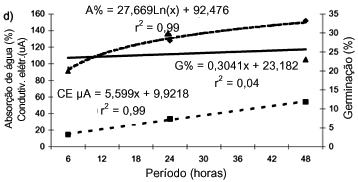Experimentos foram conduzidos em laboratório com o objetivo de determinar relações entre germinação de sementes de plantas daninhas e condutividade elétrica (CE). Foram usadas sementes de amendoim-bravo (Euphorbia heterophylla), carrapicho-de-carneiro (Acanthospermum hispidum), corda-de-viola (Ipomoea grandifolia), guanxuma (Sida rhombifolia), picão-preto (Bidens pilosa) e trapoeraba (Commelina benghalensis) recentemente colhidas. As sementes foram embebidas em água por períodos de 6 até 48 horas, na temperatura de 20 ºC, determinando-se a CE das sementes e os níveis de absorção de água. Depois disso, as sementes foram colocadas para germinar. Os maiores níveis de germinação, para sementes embebidas em água por 24 horas, foram obtidos para picão-preto (88%), amendoim-bravo (31%) e guanxuma (30%); e os menores, para corda-de-viola (5%), carrapicho-de-carneiro (4%) e trapoeraba (3%). As sementes das plantas daninhas avaliadas tendem a germinar totalmente com períodos de embebição a partir de seis horas, ao passo que a sua absorção tende a aumentar e a CE das sementes, a não acompanhar os níveis de absorção ao final de maiores períodos. O uso da condutividade elétrica merece maiores estudos, uma vez que pode contribuir para uma eficiente e mais rápida avaliação da dinâmica de bancos de sementes de plantas daninhas em lavouras.
Euphorbia heterophylla; Acanthospermum hispidum; Ipomoea grandifolia; Sida rhombifolia; Bidens pilosa; Commelina benghalensis






